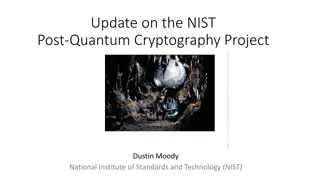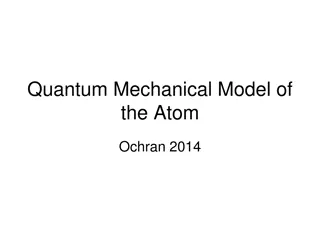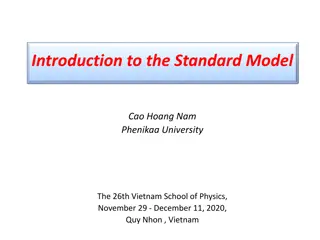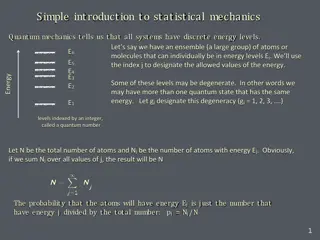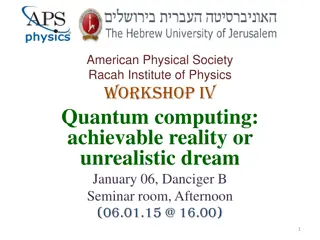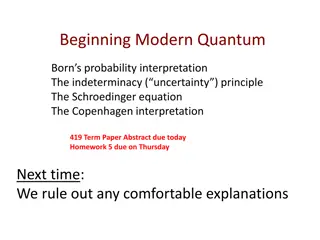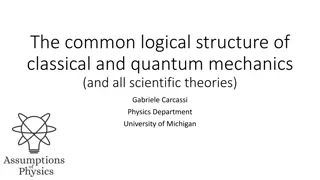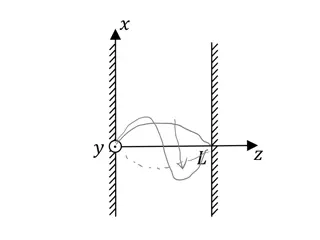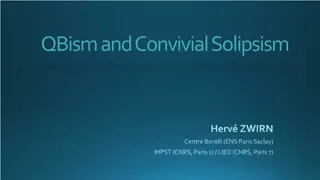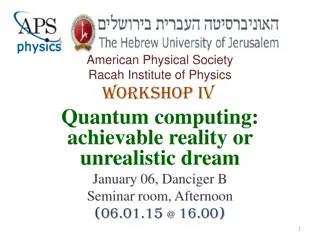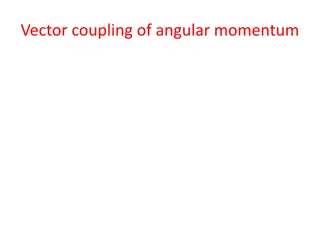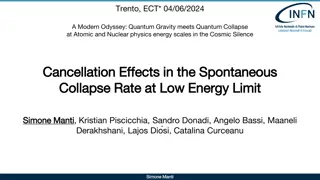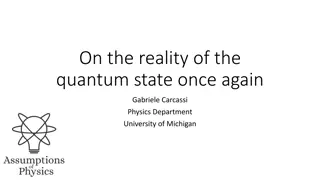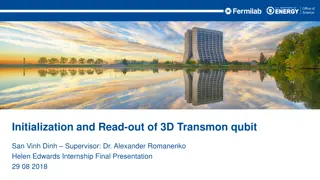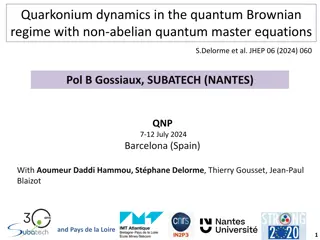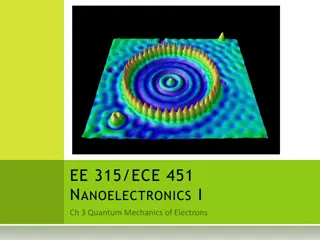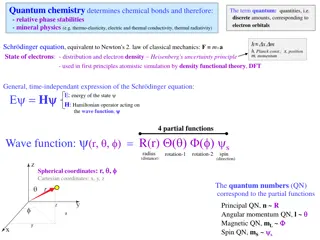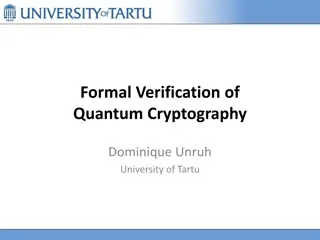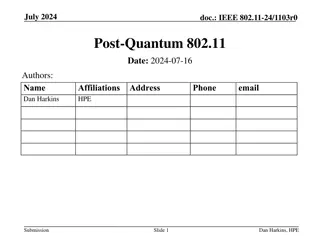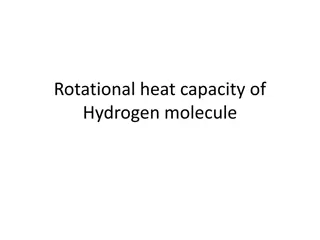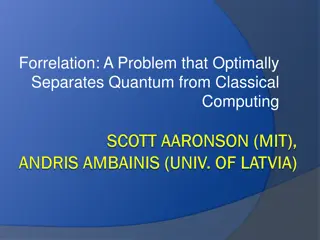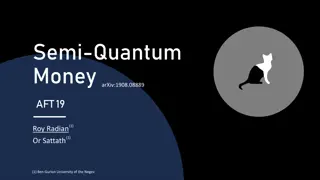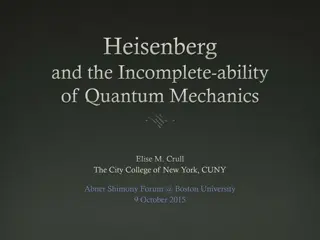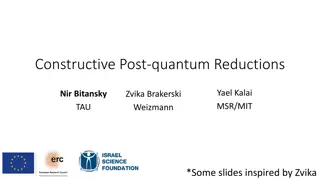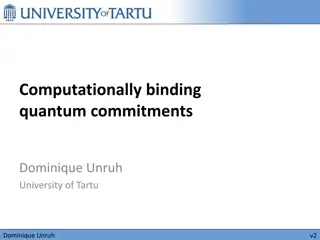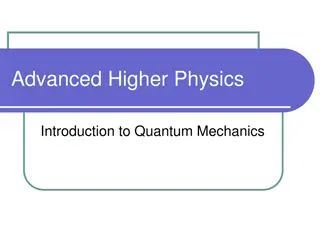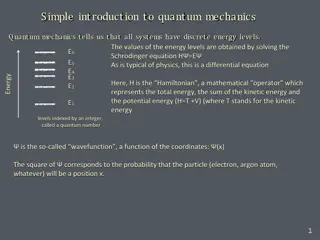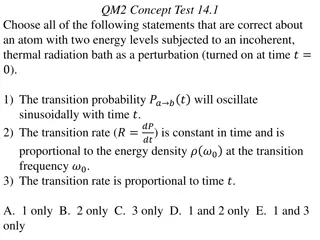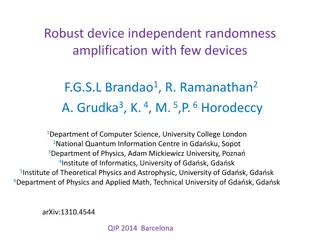Exploring the Fascinating World of Quantum Mechanics Through History
Delve into the intriguing realm of quantum mechanics starting from its basic postulates, probability amplitudes, and measurement principles. Discover how unexplained observations in atomic structures led to the development of quantum mechanics, addressing classical physics problems like Black Body Radiation. Witness significant historical discoveries and paradigm shifts that revolutionized our understanding of the physical world.
Download Presentation

Please find below an Image/Link to download the presentation.
The content on the website is provided AS IS for your information and personal use only. It may not be sold, licensed, or shared on other websites without obtaining consent from the author. Download presentation by click this link. If you encounter any issues during the download, it is possible that the publisher has removed the file from their server.
E N D
Presentation Transcript
Quantum Mechanics Soumitra Nandi PH101, Lec-2
Few basic postulates We do not have knowledge of but still we can still understand few of it s properties !! = l+ d Probability amplitudes state vector Postulate 1 (State) : The state of aliveness/deadness of the cat is the linear superposition between two possible states ! Postulate 2 : The probability of measuring an dead/alive state is the absolute square of the inner product of the desired outcome with the state! |?= |?|? Probability of measuring live state = |?.?? |?= |? ?? |?= | |? Probability of measuring dead state = |?.?? |?= |? ?? Postulate 3 (Measurement): Once the box is opened and dead/alive has been obtained, the state vector collapses into the measured state ! ??/?
A look back in history Around the beginning of the 20th century, classical physics, based on Newtonian Mechanics and Maxwell s equations of Electricity and Magnetism described nature as we knew it. Statistical Mechanics was also a well developed discipline describing systems with a large number of degrees of freedom. Special Relativity was compatible with Maxwell s equations and changed our understanding of space-time and modified Mechanics. These laws are based on experimental observations and were expressed in a manner consistent with how we understand our physical system from classical point of view !! There is no uncertainty or randomness as a consequence of our ignorance of information about a system implicit in any of these laws. The pre-quantum experimenters were unaware of the fact that the information they were gathering was not refined enough to show that there were fundamental limitations to the accuracy with which they could measure physical properties.
Unexplained observations The electron as a constituent of atoms had been found, atomic structure was rich and quite mysterious. There were problems with classical physics !! Many things remained unexplained Black Body Radiation The Photoelectric effect Basic Atomic Theory Compton Scattering, and eventually with the diffraction of all kinds of particles Problems lead to the development of Quantum Mechanics
Black Body Radiation Black Body Radiation Classical physics predicted that hot objects would instantly radiate away all their heat into electromagnetic waves. The calculation, which was based on Maxwell s equations and Statistical Mechanics, showed that the radiation rate went to infinity as the EM wavelength went to zero Energy spectrum Ultra-violet catastrophe Plank solved the problem by postulating that EM energy is emitted in quanta with E = h Data Points
Photoelectric effects Light is wave or particle like ?? Both Historically, while the Young Two Slit experiment is credited with confirming" the wave-like nature of light, it is the Photoelectric effect that shows that light also exhibits particle-like behaviour, we call light particles photons. When light was used to knock electrons out of solids, the results were completely different than expected from Maxwell s equations. Electrons will be emitted or not depends only on the frequency !! No detectable time delay in electron emission ! The frequency of the light required to liberate an electron is = 0 > ?0 / Depends on the metal used ?? = ?0 K.E of the emitted electron The measurements were easy to explain (for Einstein) if light is made up of particles with the energies Plank postulated.
Bohrs theory of Atom Atoms Classical physics predicted that the atomic electrons orbiting the nucleus would radiate their energy away and spiral into the nucleus. However, the energy radiated by atoms also came out in quantized amounts in contradiction to the predictions of classical physics. Bohr s solution was to propose that provided the electron circulates in orbits whose radii r satisfy an ad hoc rule, now known as a quantization condition, applied to the angular momentum L of the electron, L = n for n = 1,2,3 ., Orbits would be stable ! Therefore, atoms will have discrete energy levels !! Emits or absorbs light quanta by jumping between the energy levels. For hydrogen atom, it is consistent with the observation ! Bohr s theory was quite successful for the hydrogen atom, was an utter failure when applied to even the next most complex atom, the helium atom.
Compton Scattering Compton scattered high energy photons from graphite (from free electrons) ! He expected to see scattered radiation with the same frequency as that of photon or few more harmonics ! Scattered photon of longer wavelength Energy conservation Momentum conservation Shift in wavelength ! When light scattered off the electrons, it behaved just like a particle, also, changes wave length in the scattering !! One more evidence for the particle nature of light and Plank s postulate.
Particles are wave Louis de Broglie s 1924 hypothesis was much bolder than explained so far ! He proposed, with essentially no supporting evidence, that all particles, not just photons, have wave-like properties ! More precisely, if light waves of frequency can behave like a collection of particles of energy E = h , then by symmetry, a massive particle of energy E, an electron say, should behave under some circumstances like a wave of frequency = E/h A wave is also characterised by its wavelength, so it is also necessary to assign a wavelength to these matter waves . For a particle of light, a photon, the wavelength of the associated wave is = c/ ! P = h/ So what is it for a massive particle? For photon De Broglie assumed that this relationship applied to all free particles, whether they were photons or electrons or anything else.
Experimental evidences Evidence that Particles are Waves Electron diffraction In 1927, Davisson and Germer showed that electrons can be diffracted by the regular array of atoms in a crystal, which acts much like a diffraction grating. Thermal neutron diffraction Neutrons are much heavier than electrons and uncharged, so they penetrate deep inside solids and diffract from the bulk crystal structure, not the surface. He atom diffraction Beams of low-energy He atoms also diffract from crystals. Discuss in detail ! Two-slit interference Two-slit interference patterns have been created using electrons, atoms and even C60 molecules ! Atomic energy levels Direct consequence of the wave-like properties of electrons
Why Quantisation? Quantisation is a natural consequence of confining waves. Example: The harmonics of a violin string ! Only certain standing waves are allowed ! Only certain frequencies are allowed ! Only certain energies are allowed (E = h ) ! Confinement A solid is a huge box, so the allowed frequencies are very close together and a continuous absorption/emission spectrum is observed. An atom is a tiny box, so the allowed frequencies are well separated and the absorption/emission spectrum consists of discrete lines.










